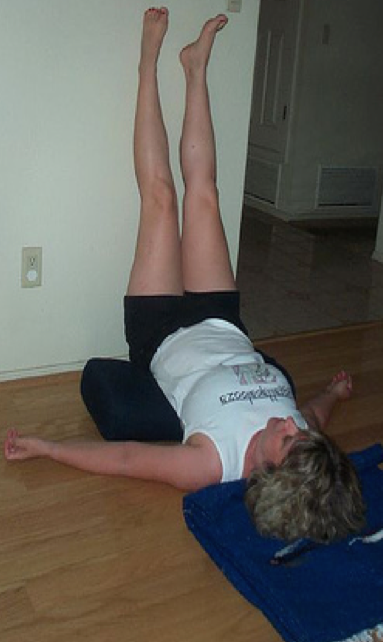You can make a difference-now-in the quality of your health by managing chronic stress.
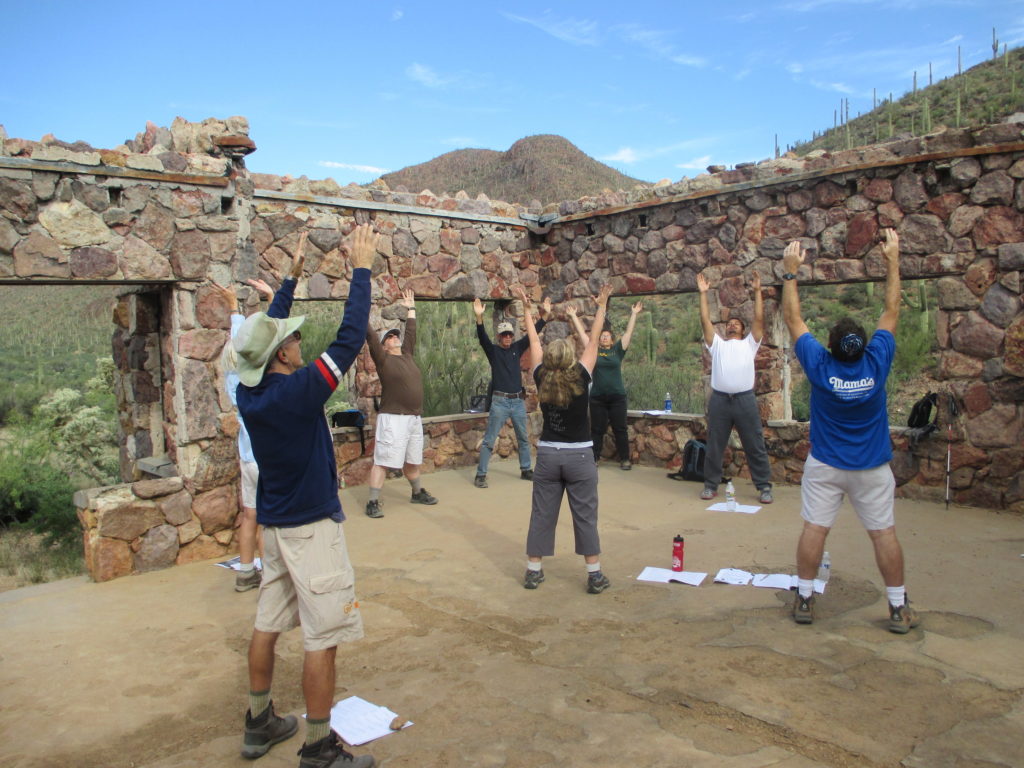
Research about the unhealthy repercussions of our chronic stress is continually released. Yet, the human body/brain/breath stress response is the same as always, as described here by the Mayo Clinic. We’ve added even more new external stressors to our lifestyle since I began teaching stress management early in my career as a counselor. These stressors include addiction to phones and uptick in societal violence.
Disease is the Price we Pay for Unmanaged, Chronic Stress .
In my recent fabulous Yoga for Healthy Aging teacher training immersion with Dr. Baxter Bell and Nina Zolotow, we reviewed the stress-disease connection. The facts about the relationship between chronic stress and disease include proven links between stress and weight gain, insomnia, and digestive disorders, in addition to heart disease, high blood pressure and stroke.
Let Go of This Stressor Today: SmartPhone and Breath Holding
Are you aware that you likely hold your breath while checking the phone? And that breath holding triggers the “fight or flight” stress response, leading to many known detrimental effects on our health? Linda Stone coined the term email apnea. By paying attention in the present moment to how you are breathing (in this case while reading through your phone), you can impact your stress levels and health.
Here are three more easily accessible tried and proven yogic practices for stress management. Included are interesting physiological responses, variations and benefits*.
Conscious breathing, and Lengthening Exhales for Relaxation
How stress is managed
Our heartbeat slows on exhalation and speeds on inhalation. Since unmanaged stress can effect our heart health and contribute to high blood pressure, slowing down our breathing, particularly our exhales, and thus our heart rate, helps us to relax.
How to practice
First Stage
- Place your hands on your belly and simply become aware of your breathing.If you can rest in your bed or on the floor with knees bent, take the time to do so. Otherwise, it’s fine to practice seated.
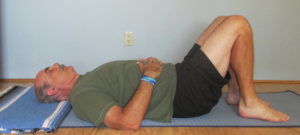
Hands gently resting on belly teaches us to feel expansion on the in-breath. - Notice the belly gently fill on the inhale and recede toward the spine on the exhale. If you are reverse breathing described in this post, learning yogic complete breath or diaphragmatic breathing with the help of a teacher can be your practice focus before moving to:
Second Stage
- Once you’ve established diaphragmatic breathing, begin to count your breaths. Our goal is for our exhales to be about twice as long as inhales.
- Example: Inhale for a count of 5 (everyone’s baseline breath capacity will differ) , and exhale for a count of 7. Repeat 6 times.
- As your breath capacity increases over time with consistent practice, inhale for a count of 5, exhale for a count of 8.
- With yoga practice, you will find that you are able to work to a 1:2 ration.
Other Benefits
-Conscious breathing, and lengthening exhales can be applied anytime or anywhere.
-No equipment needed
Mountain Pose with Arms Overhead
How Stress is Managed
Simply put: Stressed muscles, bodies, and tissues are tight and contracted. Destressed bodies, muscles, and tissues are calm and relaxed.
How to Practice
- Stand in mountain pose, feet hip joint distance apart, toes facing forward as your body allows.
- On an inhale, float your arms overhead, palms facing inward.
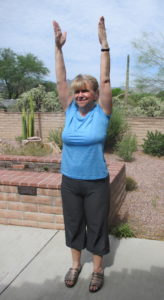
Notice the desert shapes echoing this pose? Can also practice resting on the floor. - Move and stretch slowly and gently; perhaps moving in and out of the stretch at first.
- Stay with arms over head and enjoy for 6 breaths.
- Variations: Add lateral movement, wiggle your fingers and joints.
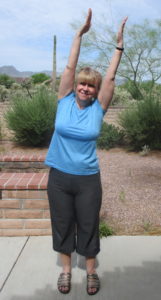
Other Benefits/Modifications
–No equipment needed
-Can be performed sitting if standing isn’t available
-Helps to relax the tissues and muscles next to the ribs, assisting us in breathing
-Helps our posture
-Energizing
-After effects of stretching are relaxing and stress relieving
-If shoulder is injured or frozen, only stretch one side or to the ROM (range of motion) that is currently Ok for your shoulder joint.
Legs up the Wall and Variations
How Stress is Managed
In this physical position of head lower than heart and the inverted nature of the pose, stimulation of baroreceptors (blood pressure receptors) occurs. These receptors reside around the areas of the heart and neck (aortic arch and carotid sinus*). Here is a great drawing from the on-line Medical Dictionary. When baroreceptors are stimulated, blood pressure lowers and we experience relaxation and calm.
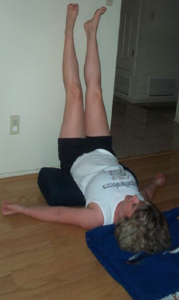
How to Practice
- Sit with right or left hip next to the wall.
- With arms behind you, swing your legs up the wall
- Distance from the wall is partially dependent on hamstring flexibility, so take time to adjust so you are as close as possible.
- Make sure hips and lower back feel supported.
- Visually adjust yourself so legs are symmetrical.
- Arms can be by the side palms up or in cactus position.
Other benefits/Modifications
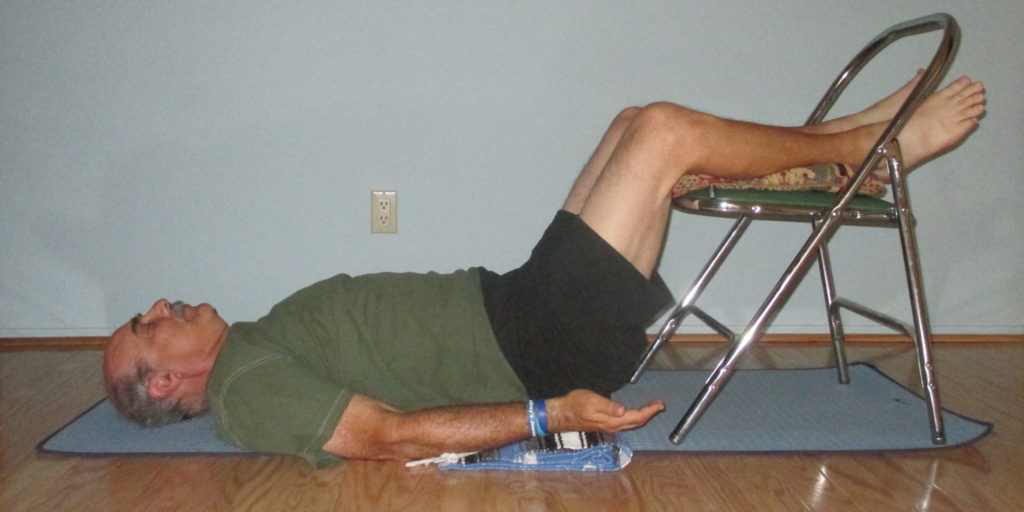
-Use props underneath hips and an eyebag.
-Can bend the knees and place soles of feet together, or slide legs open for other variations
-Can use chair (see photo)
-If you have glaucoma or high blood pressure, this pose may be counter indicated; check with your physician, since the blood pressure temporarily rises before down regulating.
-Great for people on their feet all day as feet up helps circulation.
*Sources:
Lecture material from Dr. Roger Cole, Relaxation: Physiology and Practice presented at my Relax and Renew Training and Certification with Dr. Roger Cole and Dr. Judith Lasater, San Francisco, CA 2005.
Yoga for Healthy Aging Immersion teacher training presentations with Dr. Baxter Bell and Nina Zolotow , Berkeley CA 2016

